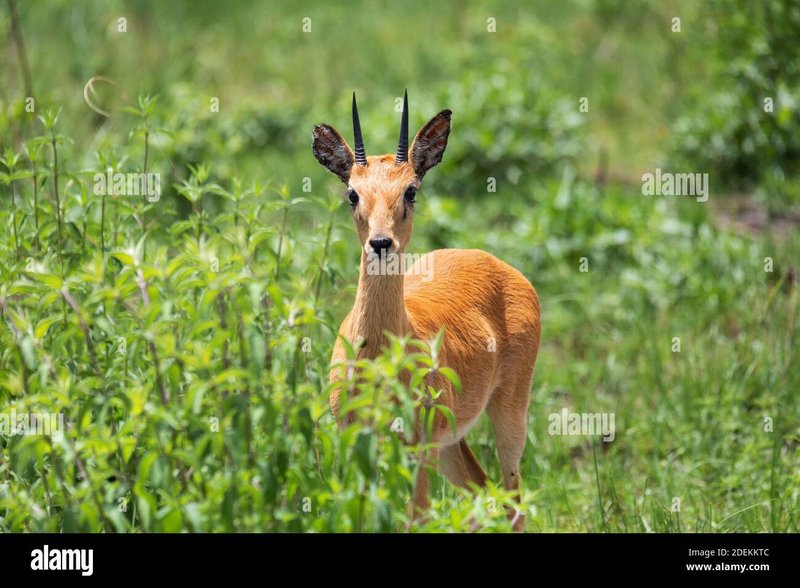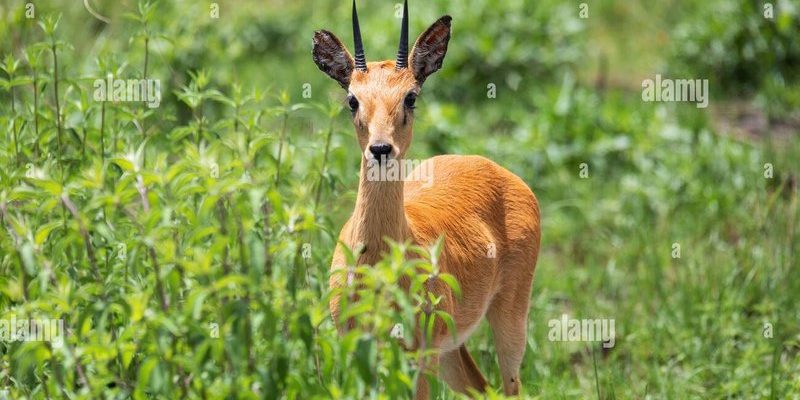
In this blog, we’ll explore the evolutionary history of the oribi, tracing its roots back through time. This will give you a clearer picture of how it evolved to become the agile and adaptable creature we see today. We’ll also touch on its behavior, habitat, and the challenges it faces in the wild. So, pour yourself a cup of coffee, sit back, and let’s dive into this captivating topic!
What Is An Oribi?
The oribi (Ourebia ourebi) is a small antelope found primarily in eastern and southern Africa. Standing about 60 to 90 centimeters tall at the shoulder, it’s a bit of a pocket-sized marvel. You might confuse it at first with other antelope species, but the oribi stands out thanks to its slender frame and short, sturdy legs.
These critters have a distinctive appearance, with a coat that ranges from light brown to reddish hue, making them blend beautifully into their grassland habitats. Their little black markings on the face and legs also lend a unique charm—like nature’s design flourishes.
Oribis are often described as shy and elusive. They’re known to make quick leaps to escape predators. This skill comes in handy, especially since they inhabit areas where they have to dodge threats like lions or hyenas.
The Origins Of The Oribi
Oribis belong to the family Bovidae, which includes cows, goats, and other antelopes. While it might seem like they popped up out of nowhere, their journey began around 20 million years ago, during the Miocene Epoch. During this time, various species of antelope were evolving and diversifying across Africa.
There are several theories on how oribis branched off from their relatives. One theory suggests that as grasslands expanded, oribis adapted to this new landscape, developing traits that helped them survive in open environments. Their smaller size, for instance, allows them to navigate through dense vegetation more easily than larger antelopes.
Interestingly, fossil evidence indicates that oribis have remained relatively unchanged compared to their ancestors. This suggests they found a successful niche early on and have continued to thrive in that role for millions of years.
Adaptations That Help Oribis Survive
Oribis have a range of adaptations that make them well-suited for their environment. One of the most striking features is their agility. These little antelopes can leap up to 2 meters high! This ability allows them to escape predators quickly and navigate through thick brush without getting stuck.
They also have excellent eyesight and keen hearing, which help them detect danger from afar. Living in open grasslands means being constantly on alert. Their physical abilities, paired with their alertness, are crucial for survival.
Moreover, oribis are browsers rather than grazers. They primarily feed on young grass shoots, leaves, and shrubs. This feeding strategy means they can thrive in areas where other grazers might struggle, thanks to their preference for lighter vegetation.
Social Structure And Behavior
Oribis are generally solitary creatures or found in small groups, typically composed of a female and her young. Their social structure is a bit different from larger antelope species, which often form herds. This more solitary lifestyle helps them maintain a low profile and avoid drawing attention from predators.
When they do come together, it’s usually in a relaxed manner. They often engage in mutual grooming, which helps to strengthen bonds between individuals. Plus, it’s a great way to stay clean!
You might be wondering how oribis communicate with one another. Besides using body language, they produce soft bleating sounds. These sounds can signal various states, from alerting others to nearby threats to expressing comfort and contentment.
Conservation Status And Threats
Despite their resilience, oribis face several threats in their natural habitats. Habitat loss due to agriculture and urban development is a significant concern. As people expand into areas where oribis live, these little antelopes lose crucial grazing and shelter areas.
Additionally, hunting remains a threat in some regions. While oribis are not targeted as heavily as larger game, they can still fall victim to poaching. Conservation efforts are becoming increasingly important to protect these animals and their habitats.
Organizations are working on habitat preservation and helping local communities find sustainable ways to coexist with wildlife. The more people understand and appreciate species like the oribi, the better chances they have for survival.
The Oribi’s Place In Ecosystems
Oribis play a significant role in their ecosystems. As browsers, they help manage vegetation growth, which can have ripple effects on the entire habitat. By feeding on plants, they help maintain a balance that supports numerous other species.
Additionally, their presence can indicate the health of grassland ecosystems. Healthy populations of oribis generally mean a well-balanced habitat that can sustain a wide array of wildlife.
This makes conservation efforts even more critical. Protecting oribis isn’t just about saving one species; it’s about ensuring the health of the entire grassland ecosystem.
The Future Of The Oribi
Looking ahead, the future of the oribi relies on collective efforts to protect their habitats. As climate change continues to affect ecosystems worldwide, it’s vital to stay informed and proactive.
This delicate creature may seem small, but it holds much larger significance within African grasslands. By supporting conservation initiatives and spreading awareness, we can help ensure that oribis continue to leap gracefully through their habitats for generations to come.
In wrapping up, the evolutionary history of the oribi is a remarkable story of resilience and adaptation. From their origins millions of years ago to the challenges they face today, these little antelopes are a testament to nature’s ability to adapt and thrive. Understanding their history not only enriches our appreciation for wildlife but also highlights the importance of conservation. Every step we take to protect these creatures contributes to the rich tapestry of life on our planet.

